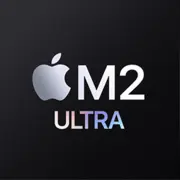Intel Core Ultra 7 265K vs Apple M2 Ultra
CPU Comparison Result
Below are the results of a comparison of
Intel Core Ultra 7 265K
and
Apple M2 Ultra
processors based on key performance characteristics, as well as power consumption and much more.
Advantages
- Higher Technology: 3 nm (3 nm vs 5 nm)
- Newer Launch Date: December 2024 (December 2024 vs May 2023)
- More Total Cores: 24 (20 vs 24)
Basic
Intel
Label Name
Apple
December 2024
Launch Date
May 2023
Desktop
Platform
Desktop
Core Ultra 7 265K
Model Name
?
The Intel processor number is just one of several factors - along with processor brand, system configurations, and system-level benchmarks - to be considered when choosing the right processor for your computing needs.
M2 Ultra
Arrow Lake-S
Code Name
Apple M2
Intel
Foundry
-
Ultra 7 (Arrow Lake-S)
Generation
-
CPU Specifications
20
Total Cores
?
Cores is a hardware term that describes the number of independent central processing units in a single computing component (die or chip).
24
20
Total Threads
?
Where applicable, Intel® Hyper-Threading Technology is only available on Performance-cores.
24
8
Performance-cores
16
12
Efficient-cores
8
3.3 GHz
Performance-core Base Frequency
3.5 GHz
1 GHz
Efficient-core Base Frequency
2.4 GHz
5.5 GHz
Performance-core Max Turbo Frequency
?
Maximum P-core turbo frequency derived from Intel® Turbo Boost Technology.
-
4.6 GHz
Efficient-core Max Turbo Frequency
?
Maximum E-core turbo frequency derived from Intel® Turbo Boost Technology.
-
112 KB per core
L1 Cache
192K per core
23 MB
L2 Cache
64MB shared
24 MB shared
L3 Cache
-
Intel Socket 1851
CPU Socket
?
The socket is the component that provides the mechanical and electrical connections between the processor and motherboard.
Apple M-Socket
Yes
Unlocked Multiplier
-
32
Multiplier
-
100 MHz
Bus Frequency
-
3 nm
Technology
?
Lithography refers to the semiconductor technology used to manufacture an integrated circuit, and is reported in nanometer (nm), indicative of the size of features built on the semiconductor.
5 nm
125 W
TDP
60 W
100 °C
Max. Operating Temperature
?
Junction Temperature is the maximum temperature allowed at the processor die.
-
5
PCIe Version
?
PCI Express is a high-speed serial computer expansion bus standard used for connecting high-speed components, replacing older standards such as AGP, PCI, and PCI-X. It has gone through multiple revisions and improvements since its initial release. PCIe 1.0 was first introduced in 2002, and in order to meet the growing demand for higher bandwidth, subsequent versions have been released over time.
-
Memory Specifications
DDR5-6400
Memory Type
?
Intel® processors come in four different types: Single Channel, Dual Channel, Triple Channel, and Flex Mode. Maximum supported memory speed may be lower when populating multiple DIMMs per channel on products that support multiple memory channels.
LPDDR5-6400
256 GB
Max Memory Size
?
Max memory size refers to the maximum memory capacity supported by the processor.
192GB
2
Memory Channels
?
The number of memory channels refers to the bandwidth operation for real world application.
16
102.4 GB/s
Max Memory Bandwidth
?
Max Memory bandwidth is the maximum rate at which data can be read from or stored into a semiconductor memory by the processor (in GB/s).
-
Yes
ECC Memory Support
-
GPU Specifications
-
Integrated Graphics Model
?
An integrated GPU refers to the graphics core that is integrated into the CPU processor. Leveraging the processor's powerful computational capabilities and intelligent power efficiency management, it delivers outstanding graphics performance and a smooth application experience at a lower power consumption.
True
Benchmarks
Geekbench 6 Single Core
Core Ultra 7 265K
3186
+20%
Apple M2 Ultra
2645
Geekbench 6 Multi Core
Core Ultra 7 265K
19799
Apple M2 Ultra
20988
+6%
Passmark CPU Single Core
Core Ultra 7 265K
4996
+19%
Apple M2 Ultra
4201
Passmark CPU Multi Core
Core Ultra 7 265K
60244
+20%
Apple M2 Ultra
50344
Share in social media
Or Link To Us
<a href="https://cputronic.com/cpu/compare/intel-core-ultra-7-265k-vs-apple-m2-ultra" target="_blank">Intel Core Ultra 7 265K vs Apple M2 Ultra</a>







